2016 NISSAN NV PASSENGER VAN warning light
[x] Cancel search: warning lightPage 10 of 380
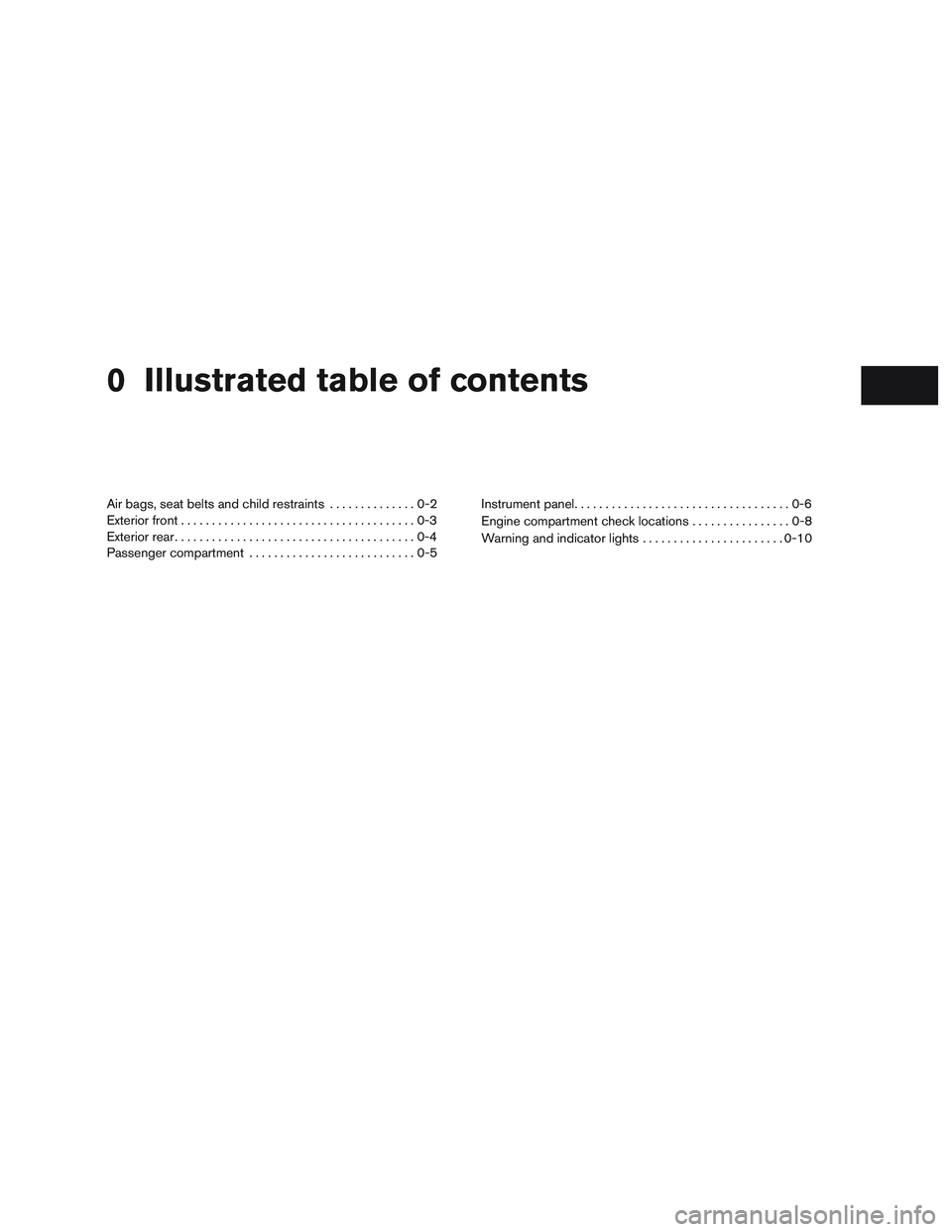
0 Illustrated table of contents
Air bags, seat belts and child restraints..............0-2
Exterior front ......................................0-3
Exterior rear .......................................0-4
Passenger compartment ...........................0-5 Instrument panel
...................................0-6
Engine compartment check locations . . ..............0-8
Warning and indicator lights .......................0-10
Page 15 of 380
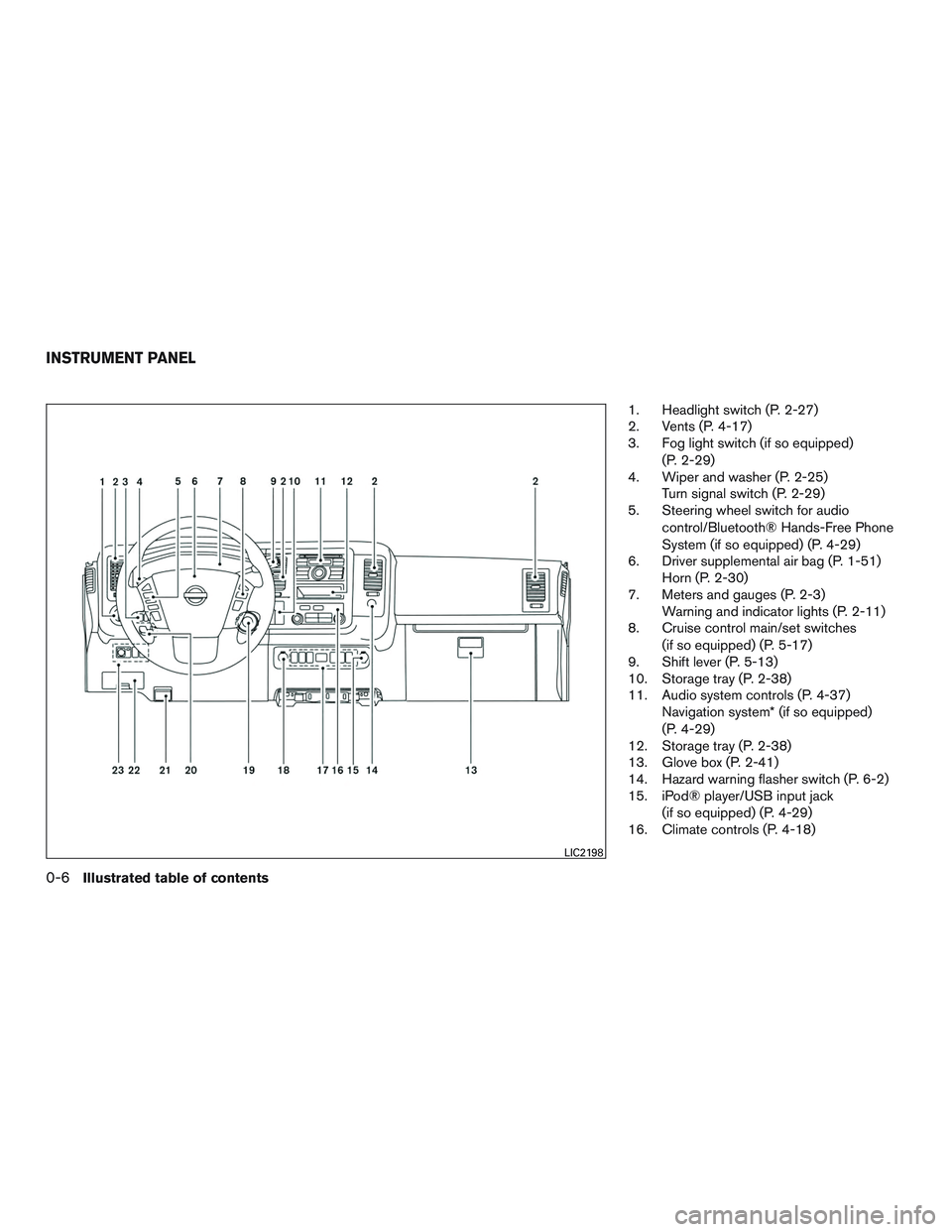
1. Headlight switch (P. 2-27)
2. Vents (P. 4-17)
3. Fog light switch (if so equipped)(P. 2-29)
4. Wiper and washer (P. 2-25) Turn signal switch (P. 2-29)
5. Steering wheel switch for audio
control/Bluetooth® Hands-Free Phone
System (if so equipped) (P. 4-29)
6. Driver supplemental air bag (P. 1-51) Horn (P. 2-30)
7. Meters and gauges (P. 2-3) Warning and indicator lights (P. 2-11)
8. Cruise control main/set switches
(if so equipped) (P. 5-17)
9. Shift lever (P. 5-13)
10. Storage tray (P. 2-38)
11. Audio system controls (P. 4-37) Navigation system* (if so equipped)
(P. 4-29)
12. Storage tray (P. 2-38)
13. Glove box (P. 2-41)
14. Hazard warning flasher switch (P. 6-2)
15. iPod® player/USB input jack
(if so equipped) (P. 4-29)
16. Climate controls (P. 4-18)
LIC2198
INSTRUMENT PANEL
0-6Illustrated table of contents
Page 19 of 380
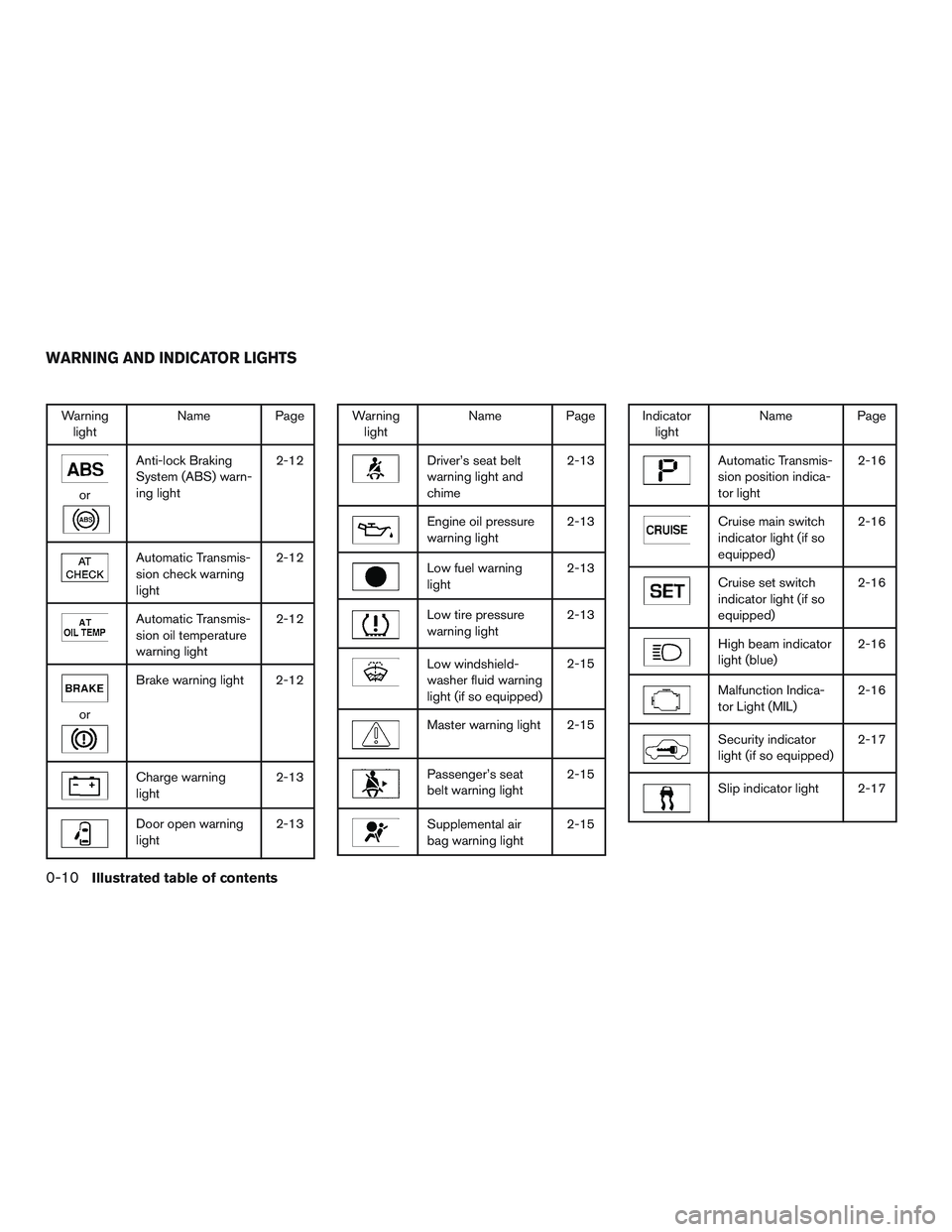
Warninglight Name Page
or
Anti-lock Braking
System (ABS) warn-
ing light 2-12
Automatic Transmis-
sion check warning
light2-12
Automatic Transmis-
sion oil temperature
warning light2-12
or
Brake warning light 2-12
Charge warning
light
2-13
Door open warning
light2-13
Warning
light Name Page
Driver’s seat belt
warning light and
chime 2-13
Engine oil pressure
warning light
2-13
Low fuel warning
light2-13
Low tire pressure
warning light2-13
Low windshield-
washer fluid warning
light (if so equipped)2-15
Master warning light 2-15
Passenger’s seat
belt warning light
2-15
Supplemental air
bag warning light2-15
Indicator
light Name Page
Automatic Transmis-
sion position indica-
tor light 2-16
Cruise main switch
indicator light (if so
equipped)2-16
Cruise set switch
indicator light (if so
equipped)2-16
High beam indicator
light (blue)
2-16
Malfunction Indica-
tor Light (MIL)2-16
Security indicator
light (if so equipped)2-17
Slip indicator light 2-17
WARNING AND INDICATOR LIGHTS
0-10Illustrated table of contents
Page 22 of 380
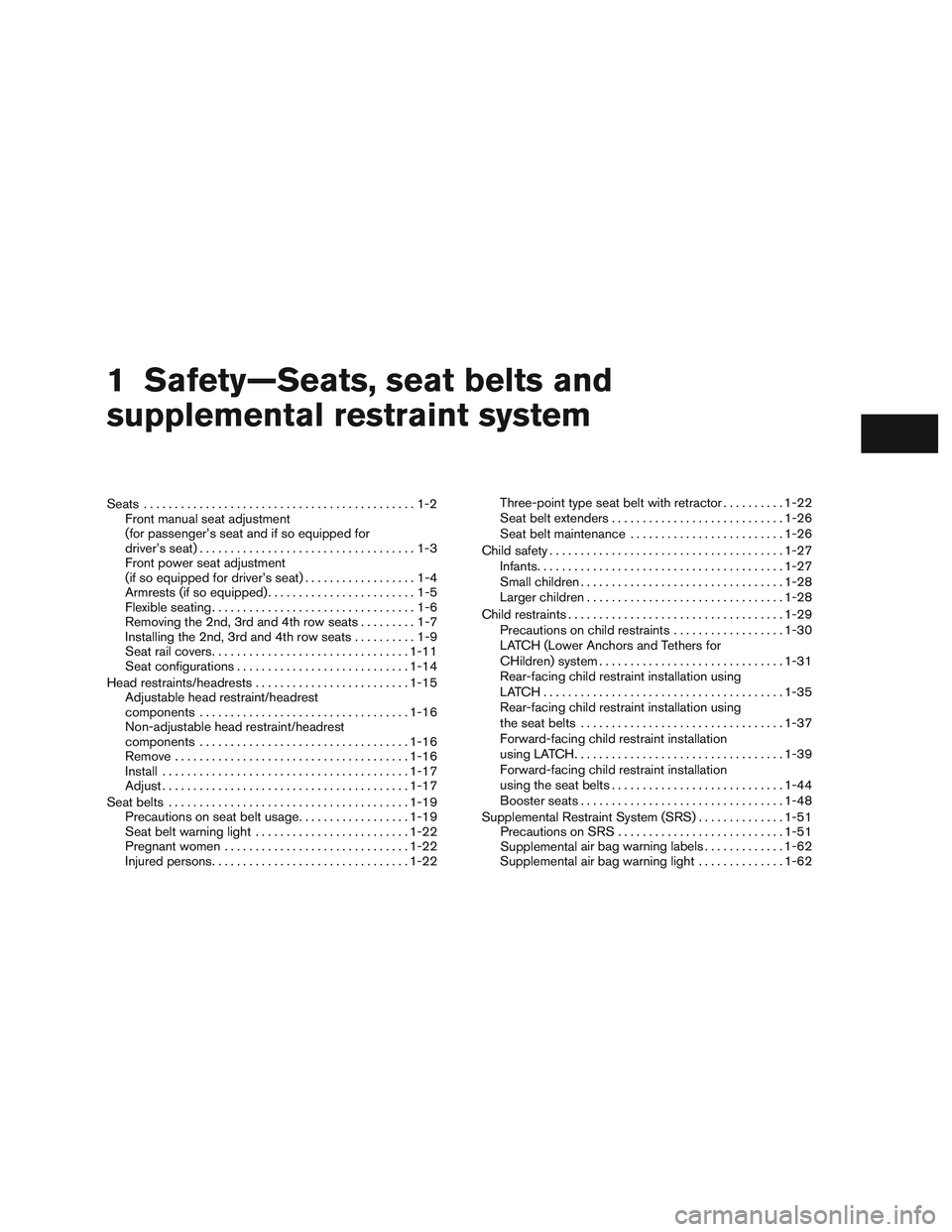
1 Safety—Seats, seat belts and
supplemental restraint system
Seats............................................1-2
Front manual seat adjustment
(for passenger’s seat and if so equipped for
driver’s seat) ...................................1-3
Front power seat adjustment
(if so equipped for driver’s seat) ..................1-4
Armrests (if so equipped) ........................1-5
Flexible seating .................................1-6
Removing the 2nd, 3rd and 4th row seats .........1-7
Installing the 2nd, 3rd and 4th row seats ..........1-9
Seat rail covers ................................ 1-11
Seat configurations ............................ 1-14
Head restraints/headrests ......................... 1-15
Adjustable head restraint/headrest
components .................................. 1-16
Non-adjustable head restraint/headrest
components .................................. 1-16
Remove ...................................... 1-16
Install ........................................ 1-17
Adjust ........................................ 1-17
Seat belts ....................................... 1-19
Precautions on seat belt usage ..................1-19
Seat belt warning light ......................... 1-22
Pregnant women .............................. 1-22
Injured persons ................................ 1-22Three-point type seat belt with retractor
..........1-22
Seat belt extenders ............................ 1-26
Seat belt maintenance ......................... 1-26
Child safety ...................................... 1-27
Infants ........................................ 1-27
Small children ................................. 1-28
Larger children ................................ 1-28
Child restraints ................................... 1-29
Precautions on child restraints ..................1-30
LATCH (Lower Anchors and Tethers for
CHildren) system .............................. 1-31
Rear-facing child restraint installation using
LATCH....................................... 1-35
Rear-facing child restraint installation using
the seat belts ................................. 1-37
Forward-facing child restraint installation
using LATCH .................................. 1-39
Forward-facing child restraint installation
using the seat belts ............................ 1-44
Booster seats ................................. 1-48
Supplemental Restraint System (SRS) ..............1-51
Precautions on SRS ........................... 1-51
Supplemental
air bag warning labels .............1-62
Supplemental air bag warning light ..............1-62
Page 42 of 380
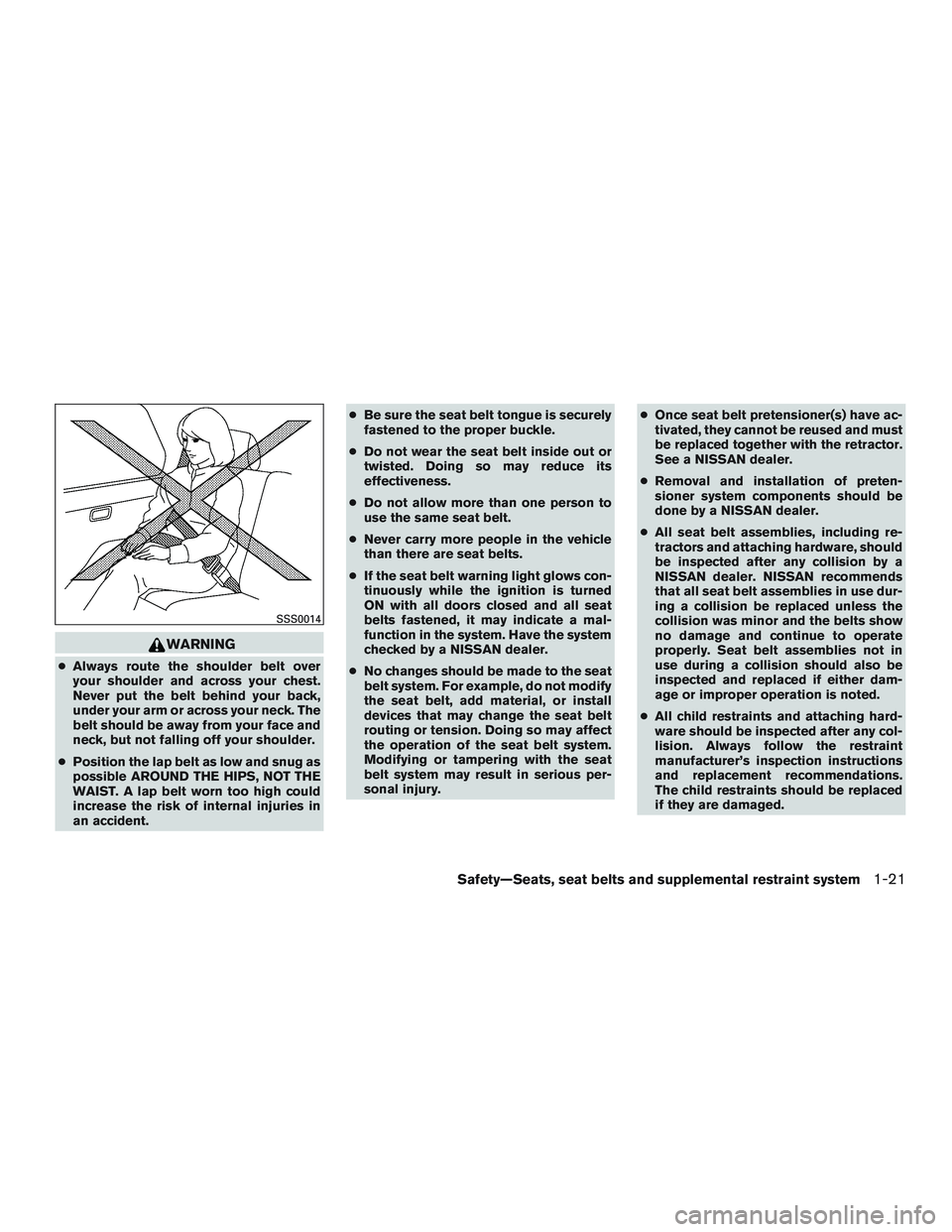
WARNING
●Always route the shoulder belt over
your shoulder and across your chest.
Never put the belt behind your back,
under your arm or across your neck. The
belt should be away from your face and
neck, but not falling off your shoulder.
● Position the lap belt as low and snug as
possible AROUND THE HIPS, NOT THE
WAIST. A lap belt worn too high could
increase the risk of internal injuries in
an accident. ●
Be sure the seat belt tongue is securely
fastened to the proper buckle.
● Do not wear the seat belt inside out or
twisted. Doing so may reduce its
effectiveness.
● Do not allow more than one person to
use the same seat belt.
● Never carry more people in the vehicle
than there are seat belts.
● If the seat belt warning light glows con-
tinuously while the ignition is turned
ON with all doors closed and all seat
belts fastened, it may indicate a mal-
function in the system. Have the system
checked by a NISSAN dealer.
● No changes should be made to the seat
belt system. For example, do not modify
the seat belt, add material, or install
devices that may change the seat belt
routing or tension. Doing so may affect
the operation of the seat belt system.
Modifying or tampering with the seat
belt system may result in serious per-
sonal injury. ●
Once seat belt pretensioner(s) have ac-
tivated, they cannot be reused and must
be replaced together with the retractor.
See a NISSAN dealer.
● Removal and installation of preten-
sioner system components should be
done by a NISSAN dealer.
● All seat belt assemblies, including re-
tractors and attaching hardware, should
be inspected after any collision by a
NISSAN dealer. NISSAN recommends
that all seat belt assemblies in use dur-
ing a collision be replaced unless the
collision was minor and the belts show
no damage and continue to operate
properly. Seat belt assemblies not in
use during a collision should also be
inspected and replaced if either dam-
age or improper operation is noted.
● All child restraints and attaching hard-
ware should be inspected after any col-
lision. Always follow the restraint
manufacturer’s inspection instructions
and replacement recommendations.
The child restraints should be replaced
if they are damaged.
SSS0014
Safety—Seats, seat belts and supplemental restraint system1-21
Page 43 of 380

SEAT BELT WARNING LIGHT
Both the driver’s and passenger’s front seats are
equipped with a seat belt warning light. The
warning light, located on the instrument panel,
will show the status of the driver and passenger
seat belt.
NOTE:
The front passenger seat belt warning light
will not light up if the seat is not occupied.
For additional information, refer to “Warning
lights, indicator lights and audible reminders” in
the “Instruments and controls” section of this
manual.
PREGNANT WOMEN
NISSAN recommends that pregnant women use
seat belts. The seat belt should be worn snug and
always position the lap belt as low as possible
around the hips, not the waist. Place the shoulder
belt over your shoulder and across your chest.
Never run the lap/shoulder belt over your ab-
dominal area. Contact your doctor for specific
recommendations.
INJURED PERSONS
NISSAN recommends that injured persons use
seat belts. Check with your doctor for specific
recommendations.
THREE-POINT TYPE SEAT BELT
WITH RETRACTOR
WARNING
●Every person who drives or rides in this
vehicle should use a seat belt at all
times. ●
Do not ride in a moving vehicle when
the seatback is reclined. This can be
dangerous. The shoulder belt will not
be against your body. In an accident,
you could be thrown into it and receive
neck or other serious injuries. You
could also slide under the lap belt and
receive serious internal injuries.
● For the most effective protection when
the vehicle is in motion, the seat should
be upright. Always sit well back and
upright in the seat with both feet on the
floor and adjust the seat belt properly.
● Do not allow children to play with the
seat belts. Most seating positions are
equipped with Automatic Locking Re-
tractor (ALR) mode seat belts. If the seat
belt becomes wrapped around a child’s
neck with the ALR mode activated, the
child can be seriously injured or killed if
the seat belt retracts and becomes
tight. This can occur even if the vehicle
is parked. Unbuckle the seat belt to
release the child. If the seat belt cannot
be unbuckled or is already unbuckled,
release the child by cutting the seat belt
with a suitable tool (such as a knife or
scissors) to release the seat belt.
LRS0786
1-22Safety—Seats, seat belts and supplemental restraint system
Page 73 of 380
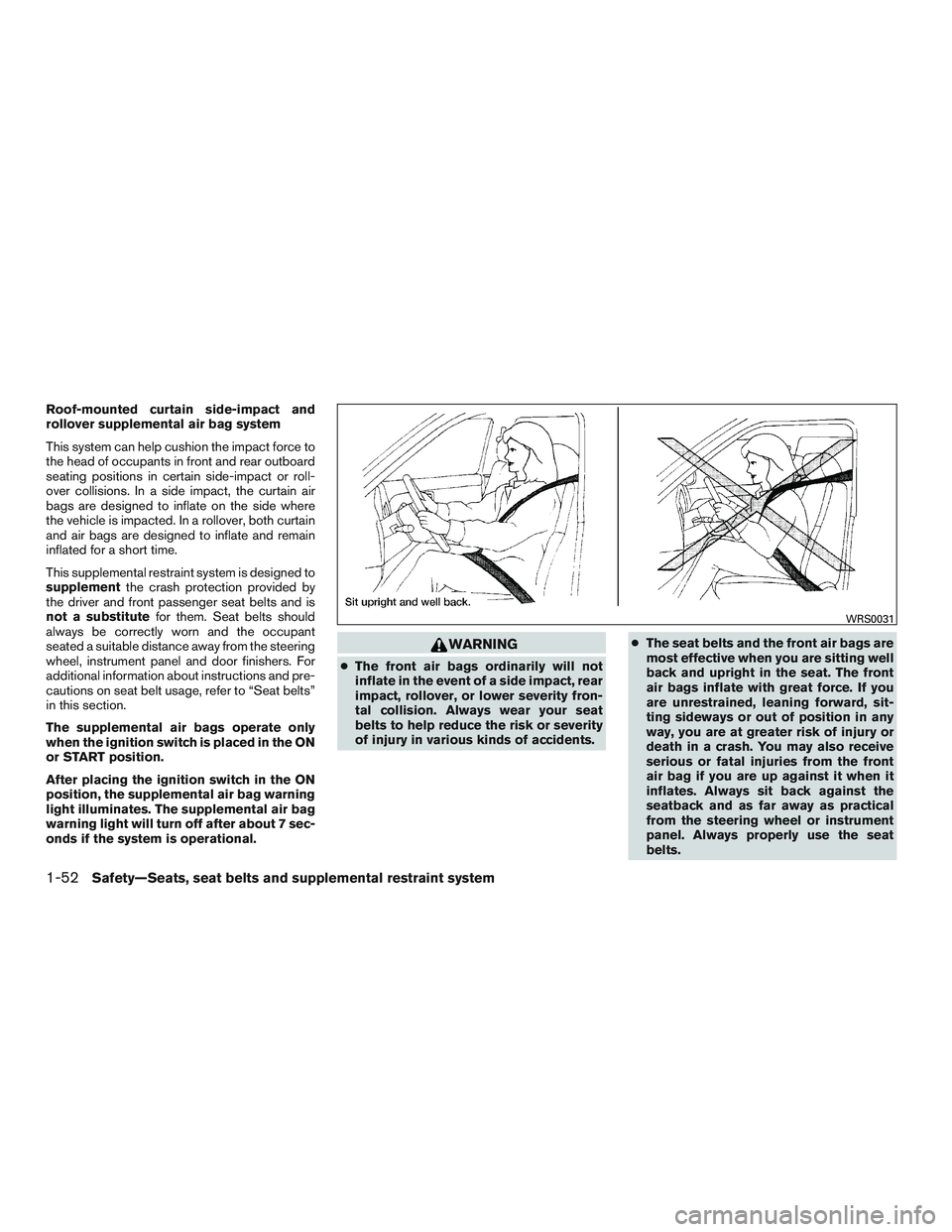
Roof-mounted curtain side-impact and
rollover supplemental air bag system
This system can help cushion the impact force to
the head of occupants in front and rear outboard
seating positions in certain side-impact or roll-
over collisions. In a side impact, the curtain air
bags are designed to inflate on the side where
the vehicle is impacted. In a rollover, both curtain
and air bags are designed to inflate and remain
inflated for a short time.
This supplemental restraint system is designed to
supplementthe crash protection provided by
the driver and front passenger seat belts and is
not a substitute for them. Seat belts should
always be correctly worn and the occupant
seated a suitable distance away from the steering
wheel, instrument panel and door finishers. For
additional information about instructions and pre-
cautions on seat belt usage, refer to “Seat belts”
in this section.
The supplemental air bags operate only
when the ignition switch is placed in the ON
or START position.
After placing the ignition switch in the ON
position, the supplemental air bag warning
light illuminates. The supplemental air bag
warning light will turn off after about 7 sec-
onds if the system is operational.
WARNING
● The front air bags ordinarily will not
inflate in the event of a side impact, rear
impact, rollover, or lower severity fron-
tal collision. Always wear your seat
belts to help reduce the risk or severity
of injury in various kinds of accidents. ●
The seat belts and the front air bags are
most effective when you are sitting well
back and upright in the seat. The front
air bags inflate with great force. If you
are unrestrained, leaning forward, sit-
ting sideways or out of position in any
way, you are at greater risk of injury or
death in a crash. You may also receive
serious or fatal injuries from the front
air bag if you are up against it when it
inflates. Always sit back against the
seatback and as far away as practical
from the steering wheel or instrument
panel. Always properly use the seat
belts.
WRS0031
1-52Safety—Seats, seat belts and supplemental restraint system
Page 79 of 380
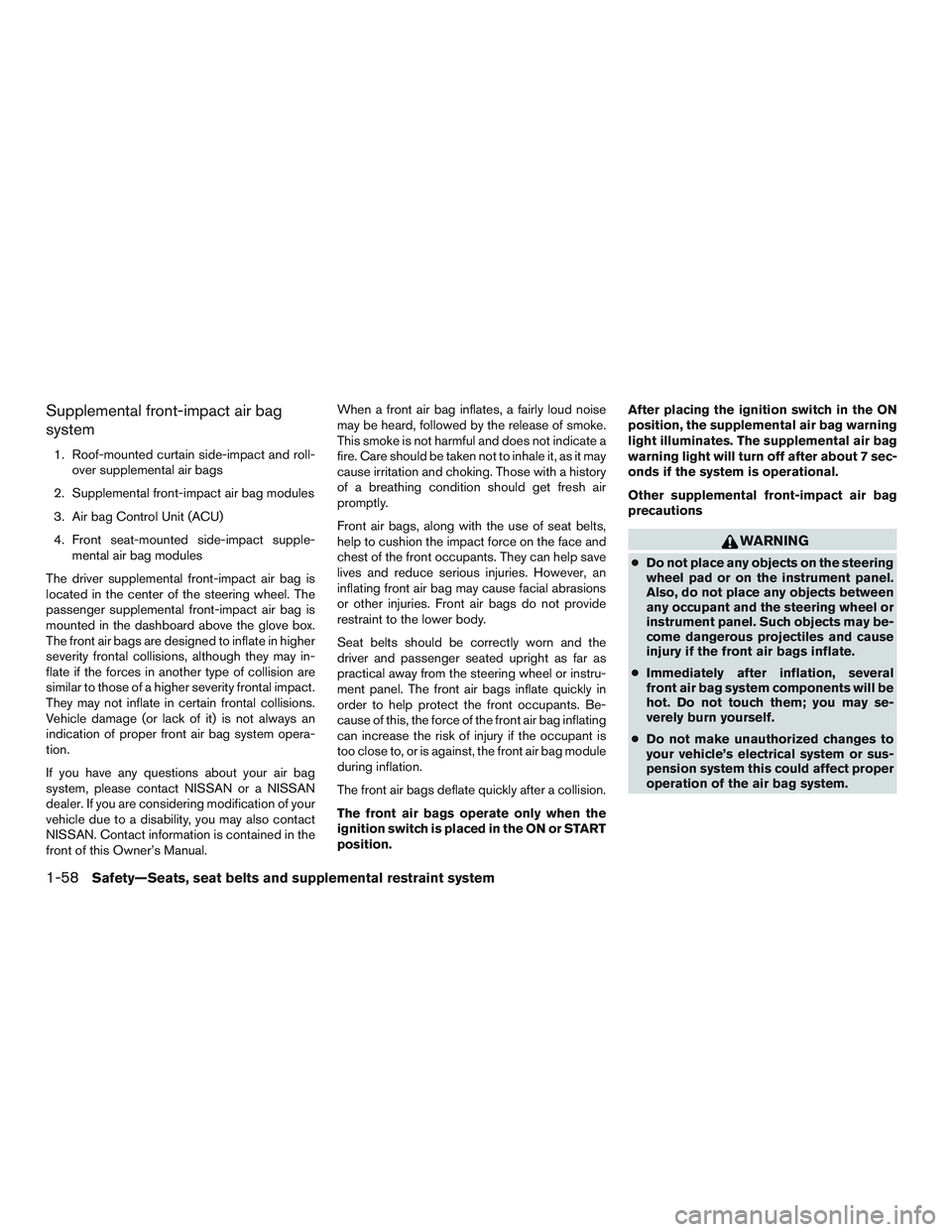
Supplemental front-impact air bag
system
1. Roof-mounted curtain side-impact and roll-over supplemental air bags
2. Supplemental front-impact air bag modules
3. Air bag Control Unit (ACU)
4. Front seat-mounted side-impact supple- mental air bag modules
The driver supplemental front-impact air bag is
located in the center of the steering wheel. The
passenger supplemental front-impact air bag is
mounted in the dashboard above the glove box.
The front air bags are designed to inflate in higher
severity frontal collisions, although they may in-
flate if the forces in another type of collision are
similar to those of a higher severity frontal impact.
They may not inflate in certain frontal collisions.
Vehicle damage (or lack of it) is not always an
indication of proper front air bag system opera-
tion.
If you have any questions about your air bag
system, please contact NISSAN or a NISSAN
dealer. If you are considering modification of your
vehicle due to a disability, you may also contact
NISSAN. Contact information is contained in the
front of this Owner’s Manual. When a front air bag inflates, a fairly loud noise
may be heard, followed by the release of smoke.
This smoke is not harmful and does not indicate a
fire. Care should be taken not to inhale it, as it may
cause irritation and choking. Those with a history
of a breathing condition should get fresh air
promptly.
Front air bags, along with the use of seat belts,
help to cushion the impact force on the face and
chest of the front occupants. They can help save
lives and reduce serious injuries. However, an
inflating front air bag may cause facial abrasions
or other injuries. Front air bags do not provide
restraint to the lower body.
Seat belts should be correctly worn and the
driver and passenger seated upright as far as
practical away from the steering wheel or instru-
ment panel. The front air bags inflate quickly in
order to help protect the front occupants. Be-
cause of this, the force of the front air bag inflating
can increase the risk of injury if the occupant is
too close to, or is against, the front air bag module
during inflation.
The front air bags deflate quickly after a collision.
The front air bags operate only when the
ignition switch is placed in the ON or START
position.
After placing the ignition switch in the ON
position, the supplemental air bag warning
light illuminates. The supplemental air bag
warning light will turn off after about 7 sec-
onds if the system is operational.
Other supplemental front-impact air bag
precautions
WARNING
●
Do not place any objects on the steering
wheel pad or on the instrument panel.
Also, do not place any objects between
any occupant and the steering wheel or
instrument panel. Such objects may be-
come dangerous projectiles and cause
injury if the front air bags inflate.
● Immediately after inflation, several
front air bag system components will be
hot. Do not touch them; you may se-
verely burn yourself.
● Do not make unauthorized changes to
your vehicle’s electrical system or sus-
pension system this could affect proper
operation of the air bag system.
1-58Safety—Seats, seat belts and supplemental restraint system